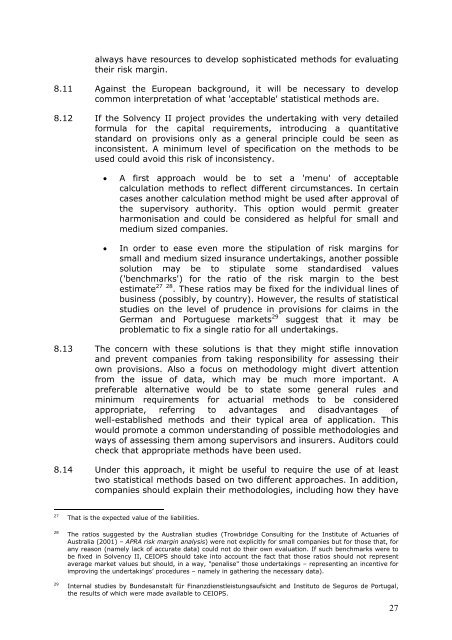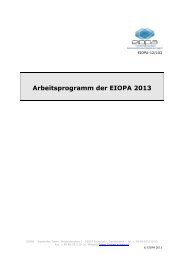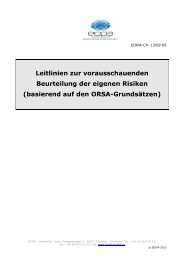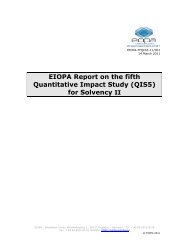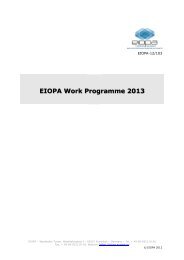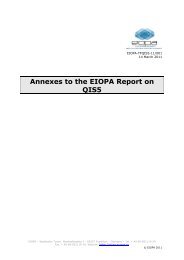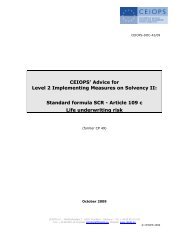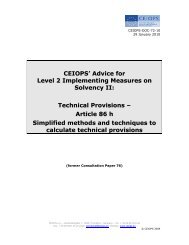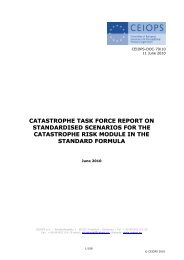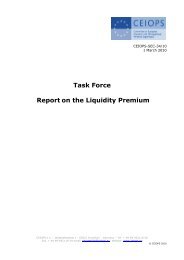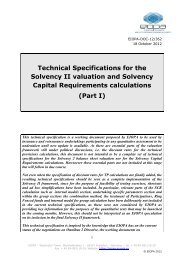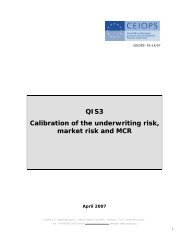Answers to the European Commission on the ... - Eiopa - Europa
Answers to the European Commission on the ... - Eiopa - Europa
Answers to the European Commission on the ... - Eiopa - Europa
You also want an ePaper? Increase the reach of your titles
YUMPU automatically turns print PDFs into web optimized ePapers that Google loves.
always have resources <str<strong>on</strong>g>to</str<strong>on</strong>g> develop sophisticated methods for evaluating<br />
<str<strong>on</strong>g>the</str<strong>on</strong>g>ir risk margin.<br />
8.11 Against <str<strong>on</strong>g>the</str<strong>on</strong>g> <str<strong>on</strong>g>European</str<strong>on</strong>g> background, it will be necessary <str<strong>on</strong>g>to</str<strong>on</strong>g> develop<br />
comm<strong>on</strong> interpretati<strong>on</strong> of what 'acceptable' statistical methods are.<br />
8.12 If <str<strong>on</strong>g>the</str<strong>on</strong>g> Solvency II project provides <str<strong>on</strong>g>the</str<strong>on</strong>g> undertaking with very detailed<br />
formula for <str<strong>on</strong>g>the</str<strong>on</strong>g> capital requirements, introducing a quantitative<br />
standard <strong>on</strong> provisi<strong>on</strong>s <strong>on</strong>ly as a general principle could be seen as<br />
inc<strong>on</strong>sistent. A minimum level of specificati<strong>on</strong> <strong>on</strong> <str<strong>on</strong>g>the</str<strong>on</strong>g> methods <str<strong>on</strong>g>to</str<strong>on</strong>g> be<br />
used could avoid this risk of inc<strong>on</strong>sistency.<br />
• A first approach would be <str<strong>on</strong>g>to</str<strong>on</strong>g> set a 'menu' of acceptable<br />
calculati<strong>on</strong> methods <str<strong>on</strong>g>to</str<strong>on</strong>g> reflect different circumstances. In certain<br />
cases ano<str<strong>on</strong>g>the</str<strong>on</strong>g>r calculati<strong>on</strong> method might be used after approval of<br />
<str<strong>on</strong>g>the</str<strong>on</strong>g> supervisory authority. This opti<strong>on</strong> would permit greater<br />
harm<strong>on</strong>isati<strong>on</strong> and could be c<strong>on</strong>sidered as helpful for small and<br />
medium sized companies.<br />
• In order <str<strong>on</strong>g>to</str<strong>on</strong>g> ease even more <str<strong>on</strong>g>the</str<strong>on</strong>g> stipulati<strong>on</strong> of risk margins for<br />
small and medium sized insurance undertakings, ano<str<strong>on</strong>g>the</str<strong>on</strong>g>r possible<br />
soluti<strong>on</strong> may be <str<strong>on</strong>g>to</str<strong>on</strong>g> stipulate some standardised values<br />
('benchmarks') for <str<strong>on</strong>g>the</str<strong>on</strong>g> ratio of <str<strong>on</strong>g>the</str<strong>on</strong>g> risk margin <str<strong>on</strong>g>to</str<strong>on</strong>g> <str<strong>on</strong>g>the</str<strong>on</strong>g> best<br />
estimate 27 28 . These ratios may be fixed for <str<strong>on</strong>g>the</str<strong>on</strong>g> individual lines of<br />
business (possibly, by country). However, <str<strong>on</strong>g>the</str<strong>on</strong>g> results of statistical<br />
studies <strong>on</strong> <str<strong>on</strong>g>the</str<strong>on</strong>g> level of prudence in provisi<strong>on</strong>s for claims in <str<strong>on</strong>g>the</str<strong>on</strong>g><br />
German and Portuguese markets 29 suggest that it may be<br />
problematic <str<strong>on</strong>g>to</str<strong>on</strong>g> fix a single ratio for all undertakings.<br />
8.13 The c<strong>on</strong>cern with <str<strong>on</strong>g>the</str<strong>on</strong>g>se soluti<strong>on</strong>s is that <str<strong>on</strong>g>the</str<strong>on</strong>g>y might stifle innovati<strong>on</strong><br />
and prevent companies from taking resp<strong>on</strong>sibility for assessing <str<strong>on</strong>g>the</str<strong>on</strong>g>ir<br />
own provisi<strong>on</strong>s. Also a focus <strong>on</strong> methodology might divert attenti<strong>on</strong><br />
from <str<strong>on</strong>g>the</str<strong>on</strong>g> issue of data, which may be much more important. A<br />
preferable alternative would be <str<strong>on</strong>g>to</str<strong>on</strong>g> state some general rules and<br />
minimum requirements for actuarial methods <str<strong>on</strong>g>to</str<strong>on</strong>g> be c<strong>on</strong>sidered<br />
appropriate, referring <str<strong>on</strong>g>to</str<strong>on</strong>g> advantages and disadvantages of<br />
well-established methods and <str<strong>on</strong>g>the</str<strong>on</strong>g>ir typical area of applicati<strong>on</strong>. This<br />
would promote a comm<strong>on</strong> understanding of possible methodologies and<br />
ways of assessing <str<strong>on</strong>g>the</str<strong>on</strong>g>m am<strong>on</strong>g supervisors and insurers. Audi<str<strong>on</strong>g>to</str<strong>on</strong>g>rs could<br />
check that appropriate methods have been used.<br />
8.14 Under this approach, it might be useful <str<strong>on</strong>g>to</str<strong>on</strong>g> require <str<strong>on</strong>g>the</str<strong>on</strong>g> use of at least<br />
two statistical methods based <strong>on</strong> two different approaches. In additi<strong>on</strong>,<br />
companies should explain <str<strong>on</strong>g>the</str<strong>on</strong>g>ir methodologies, including how <str<strong>on</strong>g>the</str<strong>on</strong>g>y have<br />
27 That is <str<strong>on</strong>g>the</str<strong>on</strong>g> expected value of <str<strong>on</strong>g>the</str<strong>on</strong>g> liabilities.<br />
28 The ratios suggested by <str<strong>on</strong>g>the</str<strong>on</strong>g> Australian studies (Trowbridge C<strong>on</strong>sulting for <str<strong>on</strong>g>the</str<strong>on</strong>g> Institute of Actuaries of<br />
Australia (2001) – APRA risk margin analysis) were not explicitly for small companies but for those that, for<br />
any reas<strong>on</strong> (namely lack of accurate data) could not do <str<strong>on</strong>g>the</str<strong>on</strong>g>ir own evaluati<strong>on</strong>. If such benchmarks were <str<strong>on</strong>g>to</str<strong>on</strong>g><br />
be fixed in Solvency II, CEIOPS should take in<str<strong>on</strong>g>to</str<strong>on</strong>g> account <str<strong>on</strong>g>the</str<strong>on</strong>g> fact that those ratios should not represent<br />
average market values but should, in a way, "penalise" those undertakings – representing an incentive for<br />
improving <str<strong>on</strong>g>the</str<strong>on</strong>g> undertakings’ procedures – namely in ga<str<strong>on</strong>g>the</str<strong>on</strong>g>ring <str<strong>on</strong>g>the</str<strong>on</strong>g> necessary data).<br />
29<br />
Internal studies by Bundesanstalt für Finanzdienstleistungsaufsicht and Institu<str<strong>on</strong>g>to</str<strong>on</strong>g> de Seguros de Portugal,<br />
<str<strong>on</strong>g>the</str<strong>on</strong>g> results of which were made available <str<strong>on</strong>g>to</str<strong>on</strong>g> CEIOPS.<br />
27


